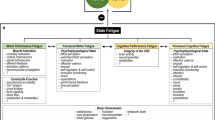Abstract
Physiological mechanisms of muscle activity during cyclic physical exercises of various intensity, including individual maximum exercise intensity, have been studied in 30 athletes. The system quantization of behavior showed that the spectral components of heart rate variability during attainment of individual maximum exercise intensity by athletes change in different directions. An increase in the individual maximum exercise intensity is accompanied by an increase in the maximum movement pace after each system quantum of muscle activity and is performed at a lower heart rate. This increases the absolute spectral power of the EEG β2 range, and each system quantum of physical activity induces adequate triggering of autonomic mechanisms ensuring the activity. The results of this study may be used for professional selection or development of criteria of the endurance of athletes with regard to high cyclic exercise intensities.
Similar content being viewed by others
References
Anokhin, P.K., Ocherki po fiziologii funktsional’nykh sistem (Essays on the Physiology of Functional Systems), Moscow, 1975.
Sudakov, K.V., Vagin, Yu.E., Andrianov, V.V., et al., Kvanty zhiznedeyatel’nosti (Quanta of Vital Activity), Moscow, 1993.
Mikhailov, V.M., Variabel’nost’ ritma serdtsa (Variability of Heart Rate), Ivanovo, 2000.
Sologub, E.B., Korkovaya regulyatsiya dvizhenii cheloveka (Cortical Regulation of Human Locomotion), Leningrad: Meditsina, 1981.
Sviderskaya, N.E., Antonov, A.G., and Glazkova, V.A., Spatial EEG Characteristics after Intense Physical Exercise, Zh. Vysh. Nerv. Deyat., 2003, vol. 53, no. 3, p. 372.
Crabbe, J.B. and Dishman, R.K., Brain Electrocortical Activity during and after Exercise: a Quantitative Synthesis, Psychophys., 2004, vol. 41, no. 4, p. 563.
Raigorodskii, D.Ya., Method of Express-diagnostics of Characteristics of the Central Nervous System with the use of Il’in’s Psychomotor Index (Tapping-test), in Prakticheskaya psikhodiagnostika: Metody i testy. Uchebnoe posobie (Practical Psychodiagnostics: Methods and Tests: A Textbook), Samara: Bakhrakh-M, 2000, p. 582.
Task Force of the European Society of Cardiology and the North American Society of Pacing and Electrophysiology. Heart Rate Variability. Standards of Measurements, Physiological Interpretation, and Clinical Use, Circulation, 1996, vol. 87, p. 1043.
Efimova, M.R. and Ryabtsev, V.M., Obshchaya teoriya statistiki (General Theory of Statistics), Moscow, 1991.
Okhromii, G.V., Auxiliary Criteria of Control of Rehabilitation Efficiency in Patients with Acute Myocardial Infarction at the first Hospital Stage of Treatment, Ukr. Kardiolog. Zh., 2004, no. 5, p. 26.
Il’ina, L.I. and Kukolevskaya, E.V., Entsefalografiya sportsmenov (Encephalography of Athletes), Moscow, 1962.
Mechau, D., Mucke, S., Weiss, M., and Liesen, H., Effect of Increasing Running Velocity on Electroencephalogram in a Field Test, Eur. J. Appl. Physiol. Occup. Physiol., 1998, vol. 78, no. 4, p. 340.
Krupnov, A.I., Study of Relationship between Background EEG Parameters and Dynamic Characteristics of Behavior, Vopr. Psikhol., 1970, no. 6, p. 47.
Sharpley, C.F. and Scuderi, C.S., Gender and Age Correlates of Adults’ Heart Rate Reactivity to a Brief Psychological Stressor: Implications for Australian Research and Practice, Austral. Psychol., 1994, vol. 29, no. 1, p. 41.
Pagani, M., Mazzuero, G., Ferrari, A. et al., Sympatovagal Interaction during Mental Stress. A Study Using Spectral Analysis of Heart Rate Variability in Healthy Control Subjects and Patients with a Prior Myocardial Infarction, Circulation, 1991, vol. 83, no. 4, suppl. 2, p. 43.
Author information
Authors and Affiliations
Additional information
Original Russian Text © I.I. Korobeinikova, E.N. Dudnik, O. Barak, D. Filippovich, N. Gruich, B. Lazhetich, K.V. Sudakov, 2007, published in Fiziologiya Cheloveka, 2007, Vol. 33, No. 4, pp. 101–108.
Rights and permissions
About this article
Cite this article
Korobeinikova, I.I., Dudnik, E.N., Barak, O. et al. Physiological characteristics of system quanta of athletic performance. Hum Physiol 33, 473–480 (2007). https://doi.org/10.1134/S0362119707040147
Received:
Issue Date:
DOI: https://doi.org/10.1134/S0362119707040147




